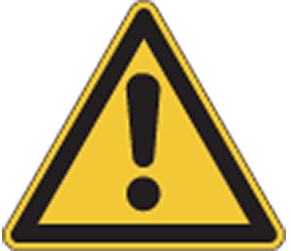Anesthesia
Many in vivo experiment are performed with narcotic gases. Narcotic gases
can have a negative impact on the operator. Read the Safety Data Sheets of the different narcotic gases and follow the instructions therein.
Different animal containments can be use during measurements. Depending on the type of the animal cradle, Waste Anesthetic Gas (WAG) can be removed from the cradle and/or the anesthesia mask. Nevertheless, the chamber or mask cannot be considered as fully air tight. Thus, a portion of anesthesia gas can escape.
In any case, follow the warnings given below.
| | |
Health hazard by anesthesia gas above regulatory limits (worker protection) Compliance with occupational safety and health regulations are in the responsibility of the System Owner (responsible body). Acute exposure to Isoflurane as well as chronic exposure can cause health hazard. - 1.
- Anesthesia gas delivered into the instrument can escape.
- •
- Use corresponding air suction in the surrounding enclosure where applicable.
- •
- Use Waste Anesthetic Gas suction from the anesthesia mask where applicable.
- •
- Operate instrument in a room with sufficient air exchange rate.
- •
- To ensure safe and adequate handling of anesthesia, only trained and authorized users may work with anesthesia gas. Repeat training on a regular base.
- •
- Check residual anesthesia gas concentration to stay within worker protection regulatory limits (for example using regularly gas personal monitors suitable for Isoflurane detection).
|
| | |
Risk of Fire Anesthesia gases may be flammable. - •
- Use non-flammable gases (e.g. isoflurane).
|
| |
Death of or harm to the animal - 1.
- The Bruker instrument is often used in combination with anesthesia devices (Trade Products) that deliver anesthesia gas. Overdose of anesthesia gas might cause the death of the animal. It is in the operators responsibility to monitor vital signs of the animal.
- •
- We recommend to use an animal monitoring system to monitor vital signs (for example heart rate, respiratory rate, body temperature, …).
- •
- Follow the instructions for use of all device suppliers such as for example the anesthesia device or animal monitoring trade product supplier.
- •
- Ensure operation of vital signs when preparing the experimental setup. For example check ECG wires and hoses of respiratory air pressure pad for blockade.
|




